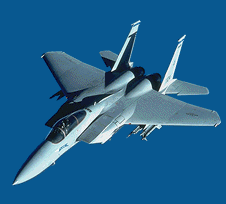McDonnell Douglas F-15E Strike Eagle


This banner was supplied by SAFE Audit

McDonnell Douglas F-15E Strike Eagle
Role: Two-seat attack/air superiority fighter.
DESIGN FEATURES:
NACA 64A aerofoil section with conical camber on
leading-edge; sweepback 38o 42' at quarter-chord;
thickness/chord ratio 6.6 per cent at root, 3 per cent
at tip; anhedral 1o; incidence 0o. Twin fins positioned
to receive vortex flow off wing and maintain
directional stability at high angles of attack.
Straight two-dimensional external compression engine
air inlet each side of fuselage. Air inlet controllers
by Hamilton Standard. Air inlet actuators by National
Water Lift. system capable of automatic coupled terrain
following.
LANDING GEAR:
Hydraulically retractable tricycle type, with single
wheel on each unit. All units retract forward.
POWER PLANT:
Initially, two Pratt & Whitney F100-PW-220 turbofans,
each rated for take-off at 104.3 kN (23450 lb st),
installed, with afterburning. Later aircraft have
option of Pratt & Whitney F100-PW-229s or General
Electric F110-GE-129s. USAF aircraft 135 onwards
(90-0233), built from August 1991, have 129.4 kN (29100
lb st) Pratt & Whitney F100-PW-229s, which also ordered
for Saudi F-15S. Internal fuel in foam-filled
structural wing tanks and six Goodyear fuselage tanks,
total capacity 7643 litres (2019 US gallons; 1681 Imp
gallons).
ACCOMMODATION:
Two crew, pilot and weapon systems officer, in tandem
on McDonnell Douglas ACES II zero/zero ejection seats.
Single-piece, upward-hinged, bird-resistant canopy.
AVIONICS:
As F-15C/D, except triple redundant Lear Astronics
digital flight control system with automatic terrain
following standard. Hughes Aircraft AN/APG-70 I-band
pulse Doppler radar provides full F-15C air-to-air
capability plus high resolution synthetic aperture
radar for air-to-ground; terrain-following capability
provided by Martin Marietta AN/AAQ-13 LANTIRN
navigation pod, and FLIR imagery displayed on Kaiser
ID-2394/A wide field of view HUD; moving map display by
Bendix/King RP-341/A remote map reader; IBM CP-1075C
very high speed integrated circuit (VHSIC) central
computer introduced in 1992, replacing CP-1075.
ARMAMENT:
20 mm M61A1 six-barrel gun in starboard wing-root, with
512 rds. General Electric lead computing gyro.
Provision on underwing (one per wing) and centreline
pylons for air-to-air and air-to-ground weapons and
external fuel tanks. Wing pylons use standard rail and
launchers for AIM-9 Sidewinder and AIM-120 AMRAAM
air-to-air missiles; AIM-7 Sparrow and AIM-120 AMRAAM
can be carried on ejection launchers on the fuselage or
on tangential stores carriers on CFTs. Edo BRU-46/A and
BRU-47/A adaptors throughout, plus two LAU-106A/As each
side of lower fuselage. F-15E can carry a wide variety
and quantity of guided and unguided air-to-ground
weapons.
DIMENSIONS: EXTERNAL:
Wing span: 42 ft 9{3/4} in
Wing aspect ratio: 3.01
Length overall: 63 ft 9 in
Height overall: 18 ft 5{1/2} in
AREAS:
Wings, gross: 608.0 sq ft
WEIGHTS: AND LOADINGS (F100-PW-220 engines):
Operating weight empty (no fuel, ammunition, pylons or external stores): 32000 lbs
Max weapon load: 24500 lbs
Max T-O weight: 81000 lbs
PERFORMANCE:
Max level speed at height: Mach 2.5
Max combat radius: 685 nm (790 miles)
Max range: 2400 nm (2762 miles)
Service Ceiling: 60,000 ft.
Aircraft Measures:
Length: 63 ft., 9 in.
Height: 18 ft., 5.5 in.
Wingspan: 42 ft., 9.75 in
Loaded Weight: 68,000 lbs
Aircraft Performance:
Maximum Speed: Mach 2.5+
Service Ceiling: 60,000 ft.
Range: 3,570 miles
Thrust: 47,660 lbs


